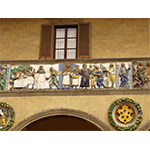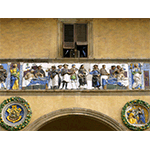Spedale del Ceppo - Museo dei Ferri Chirurgici [Hospital of Ceppo - Museum of Surgical Instruments]
Founded in 1277, the Hospital of the Infirm, known as Santa Maria del Ceppo, is one of the very oldest hospitals in Tuscany. Its name comes from an ancient tradition that recalls a "ceppo", or stump, from a chestnut tree used to collect the first contributions for building the hospital. In the following years the hospital grew rapidly thanks to numerous donations. During the Middle Ages, like other similar institutions, it was dedicated to providing relief for the poor and the ill, especially during the recurrent famines and epidemics. Near the end of the 15th century the hospital was the object of strongly conflicting interests among the city’s factions, to the point that, in 1502, it was put under the jurisdiction of the Florentine Hospital of Santa Maria Nuova.
In the early years of the 16th century the loggia was built, recalling the one designed by Brunelleschi for the Hospital "degli Innocenti". On the facade, above the loggia, the splendid glazed terracotta frieze was accomplished between 1526 and 1528. It is the work of Giovanni della Robbia and Santi Buglioni except for one panel ("Give drink to the thirsty") by the Pistoia artist Filippo di Lorenzo de' Paladini. The seven great panels of which the frieze is composed represent the Works of Charity, in alternation with the Cardinal and Theological Virtues.
The panel illustrating doctors examining patients is highly effective, as regards iconography pertaining to medicine. Against a white background evocative of the hospital environment, a physician is feeling the pulse of a sick old man, his face contorted in suffering, while an elderly personage, perhaps a servant, holds an ampule. Behind them, the pupils are waiting for the doctor to pronounce his diagnosis. At the centre of the scene appears Leonardo Buonafede, director of the Ceppo, shown listening to a doctor. The scene continues with two assistants who are helping a surgeon treat a young patient’s head wound.
In 1778 the Ceppo Hospital won back its former independence from Florence and, a few years later, Grand Duke Peter Leopold of Lorraine merged it with the San Gregorio, an ancient hospice in Pistoia that took in abandoned children, thus decreeing the birth certificate of the Associated Hospitals.
The hospital had a School of Medicine and Surgery, perhaps founded in the 1780s, although it is probable that lessons in medicine were taught here already in the previous century. In 1784 the Grand Duke approved its regulations, instituting five chairs (Practical Medicine, Institutions of Surgery, Anatomy, Practical Cases, Operations and Obstetrics) with the necessary provision of instruments. Upon completing the courses, the students had to go to Florence to take the final exam. The school trained valid physicians, among them the anatomist Filippo Pacini, until in 1839, with the reform of the system of higher studies, its closure was decreed due to the low number of students. Testimony to the school remains in the collection of antique surgical instruments kept in a special museum.
The Museum of Surgical Instruments, set up in an ancient room in the hospital, contains urological, obstetrical and orthopedic-traumatological instruments dating mainly from the 18th through the early 19th century. The instruments are of Pistoian, national (Bologna) and international (England and France) make. The Museum also contains a collection of medical texts. In the garden of the Hospital stands the restored anatomical amphitheatre dating from the 17th century.
Lastly, the pharmaceutical laboratory contains various items dating from the 18th to the 20th century: benches for the preparation of Galenic products, pharmaceutical glassware, a collection of vases and cabinets for the conservation of medicinal herbs. In the near future the Pisa ASL 3 Historical Museum, now being set up, will include the collections of the Museum of Surgical Instruments.
****************************
Texts by Graziano Magrini
English translation by Catherine Frost
Last update 29/gen/2008





